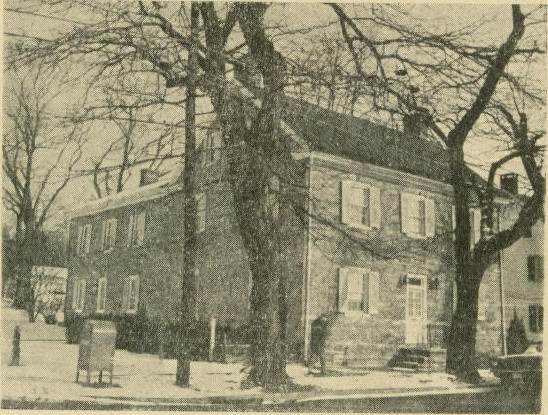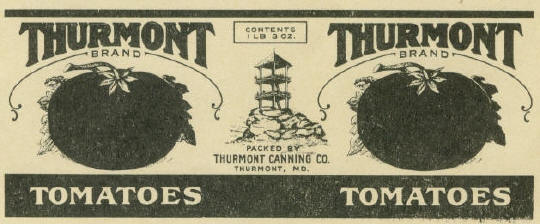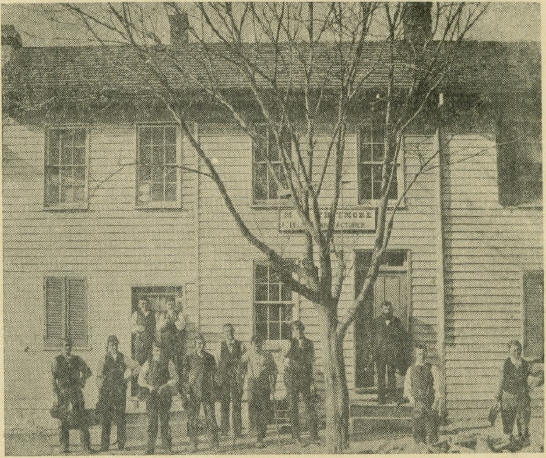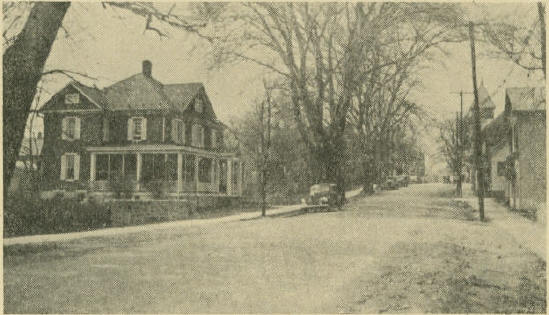|
Gateway to the Mountains
George Wireman
Chapter 6: Early
Industries
Early in its history,
Mechanicstown was the
center of considerable
manufacturing
industry, and soon
after the Rouzer
Tannery was
established, the town
began to grow rapidly.
Most of the citizens
were engaged in some
kind of work,
principally mechanics,
and from this it
derived its early
name, "Mechanicstown."
Jacob Weller, strides
across the pages of
history as a vivid
figure of
Mechanicstown, and his
interests and
attainments were
notable in this
frontier period.
As the town grew in
size and scope, it was
soon justified in
building a hotel,
principally for the
many travelers who
passed along the main
road leading through
the mountain gap to
Hagerstown and beyond.
This hotel, built in
1800, was known as the
Gilbert House and was
kept by the son of the
first settler of
Mechanicstown, Jacob
Weller. This building,
constructed of stone
from the nearby
mountains, stands
today on the "square"
and is as strong and
sturdy as the day it
was built. The
property is owned by
Mr. and Mrs. Jules
Shapiro who have
operated a clothing
store on the first
floor since their
arrival in Thurmont 20
years ago.
In 1805 Jacob Weller
built a beautiful
stone tavern directly
across the road from
his home on West Main
Street. Located on the
corner of West Main
Street and Altamont
Avenue, this home
still stands as a
monument to its
builder and is known
today by the older
citizens of the
community as the
"Johnson House." It
was given this name
when George Johnson
purchased the property
from the Weller
family. The Johnsons
maintained it in the
family until 1889 when
it was bought by the
Zimmermans. Just
recently it was
purchased by Mr. and
Mrs. Robert Dunn, who
are in the process of
restoring it with many
items of days gone by.
The Dunns are to be
congratulated for
their interest in this
old home, for there is
a lack of interest in
historic places in
this area and very few
realize the value of
holding on to things
of this nature.

The Johnson House,
West Main Street The
First Hotel, Built in
1800
Jacob Firor opened the
first store in
Mechanicstown in 1806,
but there is little
known information as
to where the store was
located and just what
items were sold there.
It is reasonable to
believe that it was
like any other
community store of its
day, handling almost
any item needed by the
citizens of the
community.
Using the power of
Hunting Creek, Jacob
Weller started an edge
tool factory in 1811.
The factory was
operated as a tilt
hammer forge and
existing records show
that this was the very
first establishment of
its kind south of New
York. He would start
the tilt hammers long
before day break and
these were said to
serve as an alarm
clock for the
early-rising
townspeople. Jacob
Weller forged edged
tools from cold steel
and became widely
known for his skill in
this trade. Tools of
all descriptions went
out from his factory
to all parts of the
South and as far as
the West Indies and
Cuba.
Weller also
manufactured pump
augurs which were used
in the manufacturing
of stock pumps. These
pumps, made by the
local pump makers,
were used extensively
in the western
counties, and until
the advent of the wind
wheels, could be found
on most every farm.
The process began by
boring a hole down the
center of oak logs ten
to fifteen feet in
length, with long
augurs. As many of
these as the depth of
the well required were
joined together, one
end fitting tightly
into the other, so as
to form a continuous
wooden pipe of
substantial character
and enduring nature,
The rod, which was
usually made of wood,
worked up and down in
this tube, by an iron
pump handle, which was
fastened at the top of
the well. A better and
more substantial pump
to be worked by hand
has scarcely ever been
devised. Mill irons
were also produced in
Mr. Weller's factory
which is said to have
flourished until
around 1850.
About the time Weller
opened his edge tool
factory, the town had
grown to such an
extent that the need
for a post office was
felt and although
there are no records
to support this fact,
it is believed that
Jacob Weller also had
a hand in this
project.
J. Conradt in 1815,
started a large woolen
mill which became very
successful and
remained in operation
for almost 40 years.
By 1820 the Hunting
Creek Tannery made its
appearance followed by
several more, which
have been covered in a
previous chapter.
Special account has
also been given in
another chapter of the
historic Catoctin Iron
Works which began in
1768.
Prior to 1860, Lynn's
Pottery, located on
the road leading to
Crow's Nest,
manufactured many fine
flower pots, crocks,
vases and jugs of all
sizes. These were
available in two
types, plain or
ornamental. Today many
beautiful pieces of
this pottery may be
found in some of the
homes of the
community. A sugar
bowl is on exhibition
at the Metropolitan
Art Museum in New
York. Just recently
Miss Catherine
Harbaugh purchased a
piece of Lynn's
pottery at a local
sale and proudly
displays it in her
home on Lombard
Street.
In 1881, Mr. Lynn
built a new pottery on
Boundry Avenue and is
said to have employed
a George H. Parker,
who was considered a
skillful master of the
trade. A sun dial,
made from the old
potter's wheel at the
Lynn Pottery was found
some years ago by the
late Albert Gernand
and was moved to his
property just west of
town.
On several occasions
my father told me of
the weaving factory
and a nail shop,
making the finest hand
wrought nails in the
county. There was a
Casket Works, carriage
and harness shops and
the Crecite Excelsior
Works. This was a very
important industry,
having been
established in 1898 by
J. Wesley Creeger,
Samuel L. Birely and
V. W. Winchester. The
original plant was
destroyed by fire but
was immediately
rebuilt on a much
larger scale and Mr.
Creeger became the
sole owner of the
business.

Around 1887 the Root
brothers organized and
built a cannery
adjacent to the
cemetery and along the
tracks of the Western
Mary-land Railroad.
This was later
destroyed by fire and
a new canningfactory
was built, known as
the Western Maryland
Canning Co. The late
Ray Taylor, a local
citizen, was
associated with the
establishment for many
years. Before the
present canning
factory closed it was
operated by a
Frederick firm known
as Jenkins Brothers,
Inc. When operating at
peak capacity the
local firm employed as
many as 130 people and
processed beans, peas
and tomatoes. Today
the site of this once
thriving industry is a
total ruin, having
been idle for many
years. During a recent
Halloween celebration,
a number of the old
labels were found
scattered along the
streets which brought
to mind memories of an
industry that once
offered employment to
many citizens in the
area, and which has
since passed from the
scene.
Around 1896, M. H.
Whitmore set up shop
on Water Street and
began the manufacture
of cigars. The shop,
located on the site
now occupied by the
home of Lillian M.
Smith, employed 12 to
14 workers and was
kept busy filling
orders for a
distributing firm in
Baltimore, Maryland.
My father worked for
the Whitmore firm
until around 1901 when
he and several others
left the cigar trade
and went to work for
the Western Maryland
Railroad.

M. H. Whitmore and
employees pose for
photographer in front
of shop
In 1832 the village of
Mechanicstown was
incorporated and a Mr.
Adelsberger became the
first mayor. Because
of the fact that the
old papers of the
first incorporation
were lost, the
Maryland Legislature
in 1870, took action
which repealed the
first incorporation. A
new one was drawn up
and the community has
been governed by this
down to the present
day.
In 1868, the John
Jones property, west
of town, was built by
Alec Wireman, a
distant relative of
the author. Mr.
Wireman owned and
operated a flour mill
near the site for many
years. The mill was
driven by water power
obtained from Hunting
Creek which runs
nearby. In 1882 the
Wireman property,
including the mill,
was purchased by John
Jones who operated the
mill until 1892, when
it was destroyed by a
fire.
A
few years later,
Daniel Rouzer built a
flour mill but did not
stay in the business
for any length of
time. It is believed
that the mill changed
hands many times. The
mill was located on
the site of the
present one, along the
tracks of the Western
Maryland Rail-road at
the north end of
Walnut Street. In 1942
the original mill was
destroyed by fire but
was rebuilt and
equipped to meet the
needs of its many
stockholders. A large
grain elevator with a
capacity of 12,000
bushels of grain was
then added and since
then many new
improvements have been
made, making it one of
the most modern and up
to date establishments
filling the farmer's
every need.
In 1928 this mill was
consolidated with
Rocky Ridge and
Sabillasville firms
and incorporated as a
farmer's cooperative.
The Thurmont
Cooperative today is
under the management
of D. Saylor Weybright.
As early as 1704, the
first newspaper in the
United States was
published. The first
newspaper to make its
appearance in
Mechanics-town was the
"Family Visitor." It
was started by Isaiah
Wolfensberger and the
printing office, said
to be one of the
liveliest spots in
town in its day, was
located on West Main
Street on the site now
occupied by the home
of Lee J. Kelbaugh.
The "Family Visitor"
had a very short life,
as the Civil War was
being fought at this
time and the paper
favored the Southern
cause and upheld the
right of a state to
secede from the Union.
About ten years later,
namely on March 4,
1871, William Need
began the publication
of the "Catoctin
Clarion" which became
widely known and a
favorite with the
citizens of
Mechanicstown. Mr.
Need's health caused
him to give up the
publishing of the
Clarion and he sold it
to Alexander P. Beatty
who continued to
operate it until 1879.
It was then sold to E.
L. Root and Charles
Cassell. Mr. Cassell
became editor and held
this position until
about 1904 when the
paper changed hands
several times and
finally in 1939, due
to the lack of proper
support, publication
of the Clarion ceased.
Up to this time there
were several editors
including H. Q.
Miller, James Firor,
J. K. White and Carl
Cassell.
In March of 1940, the
"Catoctin Enterprise"
made its appearance
under the management
of George C. Rhoderick,
Jr. of Middle-town,
with a local woman,
Miss Blanche S. Eyler
as Editor. The news of
local interest is
gathered and then sent
to Middletown where
the paper is printed
each week and then
brought back to
Thurmont for
distribution.
Since the "Enterprise"
made its first
appearance
twenty-seven years
ago, it has grown to
be a publication of
which the citizens of
the community are
mighty proud. It has
on a number of
occasions proved that
every effort is being
extended to make it
one of the finest
weekly newspapers in
the area.
In March 1959,
Thurmont, and
particularly the
"Enterprise," came in
for an unusual amount
of wide-spread
publicity during the
visit of President
Eisenhower and British
Prime Minister Harold
Macmillan to Camp
David for talks on the
Berlin situation. This
publicity through the
medium of no less a
distinguished
individual, the
renowned John Daly,
television news
commentator, put the
lo-cal weekly
publication in the
limelight on his
regular news
broad-cast on Channel
7. He spoke of the
large retinue of
newspaper, radio and
television reporters
who were in Thurmont
covering this historic
meeting of the two
world leaders. He then
interjected the remark
that "some people,
however, are hard to
impress." He then went
on to say that the "Catoctin
Enterprise," the town
newspaper, had
appeared in its
current issue with
only a short notice at
the bottom of the
front page regarding
the meeting, while a
"banner head-line" at
the top of the page
announced that "Spring
Is Here."
Mr. Daly's remarks,
made in a somewhat
humorous vein, were
indicative of the fact
that even today
metropolitan news
mediums and
particularly the news
and editorial writers
and commentators on
such mediums are
totally unaware of the
things that make up a
small, community
newspaper. There is no
question that the
staff of the
"Enterprise" was
impressed by the
presence of such
dignitaries as those
who visited Camp
David, but as
publishers of a weekly
community newspaper
they must always judge
discriminatingly
between the matters of
prime interest and
casual concern
affecting their
readers. Items which
have already been
emblazoned in
head-lines and
pictures throughout
the nation are not
calculated to get much
of a "rise" out of the
readers of a local
weekly paper. Too
often we are called
"hicks" and "yokels"
and this is not the
case. We secure all of
the information we
possibly can from the
metropolitan dailies
and tune in our
favorite television
news programs for the
latest events on the
world scene. Our
weekly publication is
more concerned with
local events and does
a fine job in covering
them from week to
week.
Recently Miss Blanche
Eyler retired as
Editor of the
Enterprise and Mrs.
Sally Benjamin took
her place in reporting
the latest news of
local interest. The
Catoctin Enterprise
has grown and
continues to thrive as
a result of a policy
of featuring the news
which interests its
readers most. Mrs.
Benjamin is doing a
very fine job and the
Enterprise is a weekly
publication of which
the community is
mighty proud.
It might be well to
point out here that
the citizens of
Thurmont have become
accustomed to seeing
world leaders and
distinguished visitors
in town and we try not
to show our concern or
create any excitement
by our emotions over
such visits. It is the
general feeling of our
citizens that this is
the way our
distinguished guests
would want it and this
is the way we try to
make it.

East Main Street,
Looking West
Chapter Index
| Chapter 7: The First Post
Office
Read other articles by George Wireman
If you have any Information or
historical news clippings on events in
the Thurmont Area, Please send them to us so we can
included them in our archives. E-mail us at:
history@mythurmont.net |